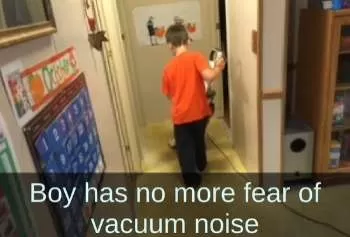Primitive Reflex Integration Case Studies
Extreme Sensitivity, Motor Skills, and Social Skills Improve
Reflex integration makes life easier for 7-year-old with sensory issues.
This young boy's sensory sensitivities interferred with using public restrooms or going to the barber, and the house being vacuumed was a highly stressful experience. His difficulties with balance and motor skills were severe enough that he could not perform ADLs such as dressing himself. After doing rhythmic movements and reflex integration from the Brain and Sensory Foundations course, he became much more regulated and independent.
Submitted by Terran Daily, Occupational Therapist

| Before | After |
|---|---|
| Screamed and cried about going into public restrooms because of the hand dryers | Able to use some less forceful hand dryers |
| Significant problems with motor skills and self care | Can now dress himself, apart from some closures, and can even unbutton his own shirt |
| Wouldn't let the barber get near him with a buzz cutter | Able to tolerate the buzz cutter on his entire head |
| Could not tolerate the sound of a vacuum cleaner | Now he's the one vacuuming! |
| Unable to balance on one leg or hop | Can balance up to 10 seconds on one leg and hop 15+ times |
| Unable to isolate finger movements and held his pencil in a dagger grasp | Can touch each fingertip to his thumb, and he holds his pencil in a good tripod grasp |
| Could not sit at circle time for more than 30 seconds without being a disruption | Can participate in group activities for 30-40 minutes, taking turns, following instructions, and respecting other children’s space. |
Finn is a 7-year-old boy who has had extreme sensory sensitivity. Last January, he screamed and cried about going into public restrooms because of the hand dryers, and would run out when the hand dryer came on. He wouldn't let the barber get near him with a buzz cutter, even to just clean up the back of his neck, and he ran away to sit on the couch when anyone vacuumed at home.
"In February, his mom started doing rhythmic movements [from the Brain and Sensory Foundations First Level course] with him, along with integration of the TLR [Tonic Labyrinthine Reflex] and hand reflexes. Within about a month, Finn was able to tolerate the buzz cutter on his entire head and was wanting to use some less forceful hand dryers, but he was still afraid of the vacuum cleaner. Mom continued with rhythmic movement over the summer, and we recently added integration of the fear paralysis and Moro reflexes. Now look—Finn is the one vacuuming!"
And sensory sensitivity is not the only thing that has improved. Finn had very significant problems with motor skills, self care and social skills as well. Initially he was completely dependent in dressing. Now he can dress himself, apart from some closures, last week he even unbuttoned his own shirt. In January, he was unable to balance on one leg or hop. Now he can balance up to 10 seconds on one leg and hop 15+ times. When we started, Finn was unable to isolate finger movements and held his pencil in a dagger grasp. Now he can touch each fingertip to his thumb, and he holds his pencil in a good tripod grasp. In January, he could sit in circle time about 30 seconds before he began throwing things and crawling over the other children. He can now usually participate meaningfully in group activities for 30-40 minutes, taking turns, following instructions, and respecting other children’s space.
[Edited for length and clarity; emphasis added]
*Disclaimer: The activities in the Brain and Sensory Foundations curriculum make use of the natural processes of neuroplasticity and development that are innately wired in the design of human beings to promote maturity and function. These activities appear to calm, organize, and mature the neuro-sensory-motor systems just as we see in the healthy development of human infants. Individual results may vary, and we do not claim to offer a diagnosis or cure for any specific condition or disorder. The Brain and Sensory Foundations activities appear to improve overall functioning resulting in measurable improvements for a range of conditions as demonstrated in over 1800 case studies from participants.

